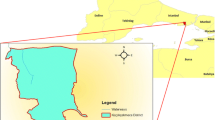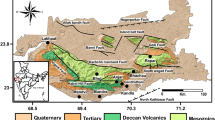Abstract
Himalayan mountains are one of the most seismo-tectonically active zones on the surface of the earth. Recurring moderate and high magnitude earthquakes are not uncommon in this region. This paper maps the earthquake vulnerability in the region using integrated multi-criteria decision models. Factors which may influence vulnerability in a region can be categorized in social, geotechnical, structural, and physical parameters. We have used the analytical hierarchy process (AHP) approach to determine the weights of various parameters, which were further used to develop earthquake vulnerability maps for the study area using the VIseKriterijumska Optimizacija I Kompromisno Resenje (VIKOR), and Grey Relational Analysis (GRA) methods. There is good correlation between the vulnerability estimated through AHP-VIKOR and AHP-GRA methods. Our analysis indicates that more than 12% area may be under high to very-high vulnerability, whereas more than 44% population, and about 43% buildings are highly vulnerable to hazards due to earthquakes. The results would be useful for various hazard mitigation and infrastructure planning agencies working in the region.






Similar content being viewed by others
References
Aghataher R, Delavar MR, Nami MH, Samnay N (2008) A Fuzzy-AHP decision support system for evaluation of cities vulnerability against earthquakes. World Appl Sci J 3(1):66–72
Alizadeh M, Hashim M, Alizadeh E, Shahabi H, Karami M, Beiranvand AP, Pradhan B, Zabihi H (2018a) Multi-criteria decision making (MCDM) model for seismic vulnerability assessment (SVA) of urban residential buildings. ISPRS Int J Geo-Inf 7:444. https://doi.org/10.3390/ijgi7110444
Alizadeh M, Alizadeh E, Asadollahpour Kotenaee S, Shahabi H, Beiranvand AP, Panahi M, Saro L (2018b) Social vulnerability assessment using an artificial neural network (ANN) model for earthquake hazard in Tabriz City, Iran. Sustainability 10(10):3376. https://doi.org/10.3390/su10103376
Ambraseys NN, Douglas J (2004) Magnitude calibration of North Indian earthquakes. Geophysical J Int 159(1):165–206
Asadi Y, Samany NN, Ezimand K (2019) Seismic vulnerability assessment of urban buildings and traffic networks using fuzzy ordered weighted average. J Mt Sci 16:677–688. https://doi.org/10.1007/s11629-017-4802-4
Bhatia SC, Kumar RM, Gupta HK (1999) A probabilistic seismic hazard map of India and adjoining regions. Ann Geofis 42(6):1153–1164
Bilham R (2015) Raising Kathmandu. Nat Geosci 8:582–584. https://doi.org/10.1038/ngeo2498
BIS (2002) IS 1893–2002 (Part 1) Indian standard criteria for earthquake resistant design of structures, Part 1–General Provisions and Buildings. Bureau of Indian Standards, New Delhi.
Boulos MNK (2003) Location-based health information services: A new paradigm in personalised information delivery. International J of Health Geographics 2(1):2. https://doi.org/10.1186/1476-072X-2-2
Brown NA, Rovins JE, Feldmann-Jensen S, Orchiston C, Johnston D (2017) Exploring disaster resilience within the hotel sector: a systematic review of the literature. Int J Disaster Risk Reduct 22:362–370. https://doi.org/10.1016/j.ijdrr.2017.02.005
Chakraborty A, Joshi PK (2016) Mapping disaster vulnerability in India using analytical hierarchy process. Geomat Nat Haz Risk 7(1):308–325. https://doi.org/10.1080/19475705.2014.897656
Chiu WY, Tzeng GH, Li HL (2013) A new Hybrid MCDM Model combining DANP with VIKOR to improve E-Store business. Knowl-Based Syst 37:48–61. https://doi.org/10.1016/j.knosys.2012.06.017
Deng J (1982) Control problems of Grey systems. Syst Control Lett 5(2):288–294
Deng J (1988) Grey system book. Science and Technology Information Services: Windsor
Dewey JF, Cande S, Pitman WC (1989) Tectonic evolution of the India/Eurasia collision zone. Eclogae Geol Helv 82:717–734
Duzgun HSB, Yucemen MS, Kalaycioglu HS, Celik K, Kemec S, Ertugay K, Deniz A (2011) An integrated earthquake vulnerability assessment framework for urban areas. Nat Hazards. https://doi.org/10.1007/s11069-011-9808-6
Ebert A, Kerle N (2008) Urban social vulnerability assessment using object-oriented analysis of remote sensing and GIS data- a case study for Tegucigalpa, Honduras. Int. Arch Photogramm Remote Sens Spat Inf Sci 37:1307–1312
Hamzaçebi C, Pekkaya M (2011) Determining of stock investments with grey relational analysis. Expert Syst Appl 38(8):9186–9195
Haq AN, Marimuthu P, Jeyapaul R (2008) Multi response optimization of machining parameters of drilling Al/SiC metal matrix composite using grey relational analysis in the Taguchi method. The Int J of Adv Manufacturing Tech 37:250–255
Hassanzadeh R, Nedovi’c-Budi’c Z, Razavi AA, Norouzzadeh M, Hodhodkian H (2013) Interactive approach for GIS-based earthquake scenario development and resource estimation (Karmania hazard model). Comput Geosci 51:324–338. https://doi.org/10.1016/j.cageo.2012.08.016
Hosseini KA, Hosseini M, Jafari MK, Hosseinioon S (2009) Recognition of vulnerable urban fabrics in earthquake zones: A case study of the Tehran metropolitan area. J Seismol Earthq Eng 10:175–187
Jankowski P, Nyerges T (2001) GIS-supported collaborative decision-making results of an experiment. Ann Assoc Am Geogr 91(1):48–70. https://doi.org/10.1111/0004-5608.00233
Jena R, Pradhan B, Beydoun G, Nizamuddin A, Sofyan H, Affan M (2019) Integrated model for earthquake risk assessment using neural network and analytic hierarchy process: Aceh Province, Indonesia. Geosci Front 11:613–634. https://doi.org/10.1016/j.gsf.2019.07.006
Jena R, Pradhan B, Beydoun G (2020) Earthquake vulnerability assessment in Northern Sumatra province by using a multi-criteria decision-making model. Int J Disaster Risk Reduct. https://doi.org/10.1016/j.ijdrr.2020.101518
Karaman H, Erden T (2014) Net earthquake hazard and elements at risk (NEaR) map creation for city of Istanbul via spatial multi-criteria decision analysis. Nat Hazards 73:685–709. https://doi.org/10.1007/s11069-014-1099-2
Karimzadeh S, Miyajima M, Hassanzadeh R, Amiraslanzadeh R, Kamel B (2014) A GIS-based seismic hazard, building vulnerability, and human loss assessment for the earthquake scenario in Tabriz. Soil Dyn Earthq Eng 66:263–280. https://doi.org/10.1016/j.soildyn.2014.06.026
Kuo Y, Yang T, Huang G-W (2007) The use of grey relational analysis in solving multiple attribute decision-making problems. Comput Ind Eng 55:80–93
Liu HC, Mao LX, Zhang ZY, Li P (2013) Induced aggregation operators in the VIKOR method and its application in material selection. Appl Math Model 37:6325–6338. https://doi.org/10.1016/j.apm.2013.01.026
Malczewski J, Liu X (2014) Local ordered weighted averaging in GIS-based multi-criteria analysis. Spatial Sci 20(2):117–129. https://doi.org/10.1080/19475683.2014.904439
Manshoori MR (2011) Evaluation of Seismic Vulnerability and failure modes for pipelines. Procedia Engineering 14:3042–3049. https://doi.org/10.1016/j.proeng.2011.07.383
Mardani A, Zavadskas E, Govindan K, Amat SA, Jusoh A (2016) VIKOR technique: a systematic review of the state of the art literature on methodologies and applications. Sustainability 8(1):37. https://doi.org/10.3390/su8010037
Martins VN, e Silva DS, Cabral P (2012) Social vulnerability assessment to seismic risk using multi-criteria analysis: the case study of Vila Franca de Campo (Miguel Island, Azores, Portugal). Nat Hazards 62:385–404. https://doi.org/10.1007/s11069-012-0084-x
Meng Y, Malczewski J (2015) A GIS-based multi-criteria decision-making approach for evaluating accessibility to public parks in Calgary, Alberta. Human Geogr 9(1):29. https://doi.org/10.5719/hgeo.2015.91.3
Merciu C, Ianos I, Merciu G, Jones R, Pomeroy G (2018) Mapping accessibility for earthquake hazard response in the historic urban centre of Bucharest. Nat Hazards Earth Syst Sci 18:2011–2026
Nath SK, Adhikari MD, Devaraj N, Maiti SK (2015) Seismic vulnerability and risk assessment of Kolkata City, India. Nat Hazard 15:1103–1121. https://doi.org/10.5194/nhess-15-1103-2015
NPC (2015) Post-disaster need assessment, vol. A and B. Government of Nepal, Kathmandu, Nepal
Nyimbili PH, Erden T, Karaman H (2018) Integration of GIS, AHP, and TOPSIS for earthquake hazard analysis. Nat Hazards 92:1523–1546. https://doi.org/10.1007/s11069-018-3262-7
Opricovic S (1998) Multicriteria optimization of civil engineering systems. Faculty of Civil Engineering, Belgrade 2(1):5–21
Opricovic S, Tzeng GH (2004) Compromise solution by MCDM methods: a comparative analysis of VIKOR and TOPSIS. European J of Operational Research 156:445–455. https://doi.org/10.1016/S0377-2217(03)00020-1
Orchiston C (2012) Seismic risk scenario planning and sustainable tourism management: Christchurch and the Alpine Fault zone. J Sustain Tour 20:59–79. https://doi.org/10.1080/09669582.2011.617827
Pal I, Nath SK, Shukla K, Pal DK, Raj A, Thingbaijam KKS, Bansal BK (2008) Earthquake hazard zonation of Sikkim Himalaya using a GIS platform. Nat Hazards 45:333–377
Panahi M, Rezaie F, Meshkani SA (2014) Seismic vulnerability assessment of school buildings in Tehran city based on AHP and GIS. Nat Hazards Earth Syst Sci 14:969–979. https://doi.org/10.5194/nhessd-1-4511-2013
Panjamani A, Bajaj K, Moustafa SSR, Al-Arifi NSN (2016) Relationship between intensity and recorded ground-motion and spectral parameters for the Himalayan region. Bull Seismol Soc Am 106:1672–1689
Rahman N, Ansary MA, Islam I (2015) GIS-based mapping of vulnerability to earthquake and fire hazard in Dhaka city, Bangladesh. Int J Disaster Risk Reduct 13:291–300. https://doi.org/10.1016/j.ijdrr.2015.07.003
Rahman MM, Bai L, Khan NG, LI G (2017) Probabilistic seismic hazard assessment for Himalayan-Tibetan region from Historical and instrumental Earthquake Catalogs. Pure Appl Geophys 175:685–705. https://doi.org/10.1007/s00024-017-1659-y
Rashed T, Weeks J (2003) Assessing vulnerability to earthquake hazards through spatial multi-criteria analysis of urban areas. Int J Geogr Inf Sci 17:547–576. https://doi.org/10.1080/1365881031000114071
Roark MS, Truman KZ, Gould PL (2000) Seismic vulnerability of airport facilities. 12WCEE
Ruddock A (2007) Hers and His: A Gendered Perspective on Disaster. Human Rights in Global Light 77.
Rupakhety R (2018) Seismotectonic and engineering seismological aspects of the Mw 7.8 Gorkha, Nepal, Earthquake. In: Impacts and insights of the Gorkha earthquake, chapter 2. https://doi.org/10.1016/B978-0-12-812808-4.00002-X
Rygel L, O’Sullivan D, Yarnal BA (2006) Method for constructing a social vulnerability index: an application to hurricane storm surges in a developed country. Mitig Adapt Strategies Glob Change 11:741–764. https://doi.org/10.1007/s11027-006-0265-6
Saaty TL (1980) The analytic hierarchy process: planning, priority setting, resource allocation. New York: McGraw 281
Schilderman T (2004) Adapting traditional shelter for disaster mitigation and reconstruction: experiences with community-based approaches. Build Res Inf 32(5):414–426
Soe M, Ryutaro T, Ishiyama D, Takashima I, Charusiri, KWIP (2009) Remote sensing and GIS-based approach for earthquake probability map: a case study of the northern Sagaing fault area. Myanmar J Geol Soc Thail 29–46
Swinscow TDV (1997) In: Statistics at square one, 9th edn. University of Southampton, Campbell M J
Szeliga W, Hough S, Martin S, Bilham R (2010) Intensity, magnitude, location, and attenuation in India for felt earthquakes since 1762. Bull of the Seism Society of Am 100(2):570–584
Walker BB, Taylor-Noonan C, Tabbernor A et al (2014) A multi-criteria evaluation model of earthquake vulnerability in Victoria, British Columbia. Nat Hazards 74:1209–1222. https://doi.org/10.1007/s11069-014-1240-2
Wieland M (2016) Safety aspects of sustainable storage dams and earthquake safety of existing dams. Engineering 2:325–331. https://doi.org/10.1016/J.ENG.2016.03.011
Wisner B, Blaikie P, Cannon T, Davis I (2003) At Risk: Natural Hazards, People’s Vulnerability, and Disasters, second ed, Routledge. Abingdon, UK:11–13
Wu W, Peng Y (2016) Extension of grey relational analysis for facilitating group consensus to an oil spill emergency management. Ann Oper Res 238(1):615–635
Xi-wei X (2010) Wenchuan earthquake induced landslides: an overview. Geological Rev 56(6):860–874
Zavadskas EK, Turskis Z (2011) Multiple criteria decision making (MCDM) methods in economics: An overview. Technol Econ Dev Econ 17:397–427
Zhang P, Yang Z, Gupta HK, Bhatia SC, Shedlock KM (1999) Global seismic hazard assessment program (GSHAP) in continental Asia. Ann Geofis 42(6):1167–2119
Acknowledgements
The authors thank the Indian Institute of Technology Kharagpur, India, and the Ministry of Education, Govt. of India for providing financial support through Ph.D. fellowship to the first author. We also extend our sincere thanks to various agencies for providing the data used in this study in the public domain. Our sincere thanks to the Editor, and the anonymous reviewers for providing constructive comments on the original manuscript which significantly enhanced the overall quality of our work.
Author information
Authors and Affiliations
Corresponding author
Ethics declarations
Conflict of interest
The authors declare that they have no conflict of interest.
Additional information
Publisher's Note
Springer Nature remains neutral with regard to jurisdictional claims in published maps and institutional affiliations.
Rights and permissions
About this article
Cite this article
Malakar, S., Rai, A.K. Earthquake vulnerability in the Himalaya by integrated multi-criteria decision models. Nat Hazards 111, 213–237 (2022). https://doi.org/10.1007/s11069-021-05050-8
Received:
Accepted:
Published:
Issue Date:
DOI: https://doi.org/10.1007/s11069-021-05050-8




